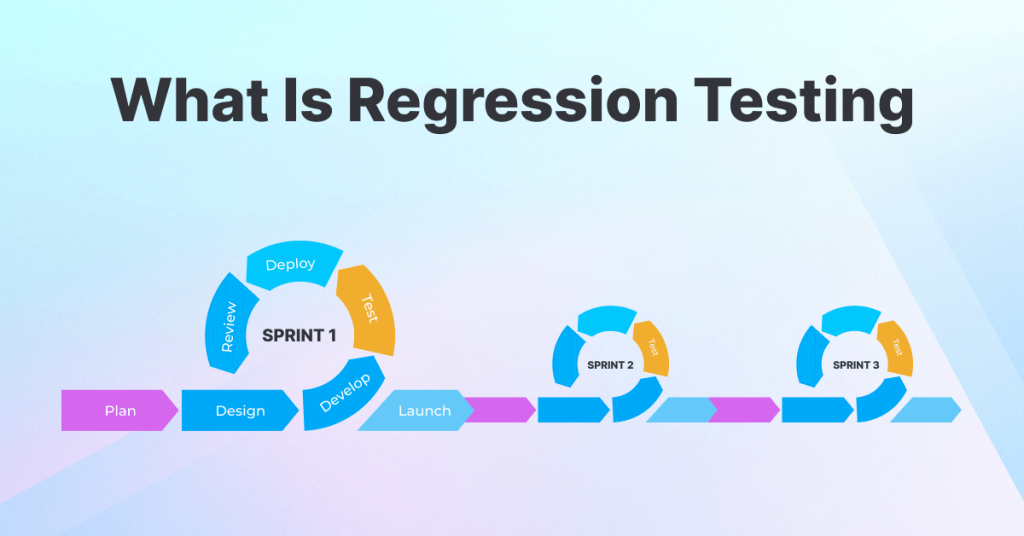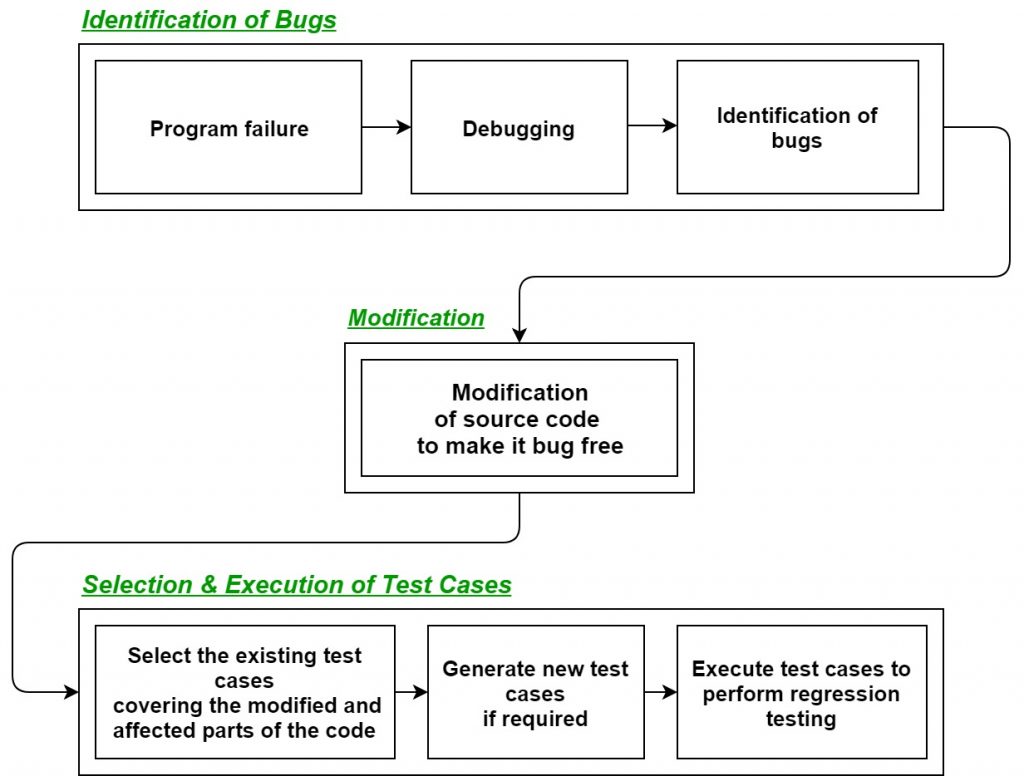
Hey All,
In this tutorial, I would let you know about the Regression Testing in manual testing.
What is Regression Testing?

Regression testing is a fundamental part of software development. It is conducted to verify that recent changes, such as bug fixes, new features, or configuration adjustments, do not disrupt the existing functionality of software applications.
The Purpose of Regression Testing:
The primary goal of regression testing is to prevent the introduction of regressions, which are newly occurring bugs caused by code modifications. Identifying these regressions early is crucial as they can be both expensive and time-consuming to rectify.
Types of Regression Testing:
- Full Regression Testing: This method involves re-executing all the test cases that were initially run during the software’s first testing phase. While comprehensive, it can be time-intensive, especially for large applications.
- Partial Regression Testing: In this approach, a subset of the original test cases is re-run. It strikes a balance between thoroughness and time efficiency, making it a practical choice for certain scenarios.
The choice between full and partial regression testing depends on factors like software size, complexity, available testing time, and the risk associated with introducing new issues.
Regression Testing Methods:
Regression testing can be conducted manually or automated using specialized tools. Manual regression testing, though meticulous, is time-consuming and prone to human error. It is particularly useful for testing intricate or difficult-to-automate functionalities.
Automated regression testing, on the other hand, is swift and dependable. However, it requires the development and upkeep of automation scripts to function effectively.
Integral to Software Development:
Regular regression testing is integral to the software development lifecycle. By incorporating this practice, development teams ensure the reliability and bug-free operation of their software. It safeguards against unintended consequences, allowing for a seamless user experience.
Importance of Regression Testing in Manual Testing

Regression testing holds significant importance in manual testing as it ensures that alterations made to existing software do not disrupt its current functionality. Even minor changes in a software system can lead to unintended consequences, potentially impacting the user experience significantly.
In manual regression testing, testers meticulously execute test cases to confirm that the software behaves as intended after modifications. Although this process can be time-consuming and demanding, it is crucial to maintain the software’s reliability and usability.
Key Benefits of Regression Testing in Manual Testing:
- Preventing Regressions: Regression testing helps detect regressions, which are bugs introduced due to changes. Timely identification of these regressions prevents user-facing issues.
- Enhancing Software Quality: By ensuring that the software remains reliable and bug-free post-changes, regression testing contributes to an improved user experience and reduces the number of support queries.
- Cost Reduction: By averting regressions, regression testing lowers development costs by eliminating the need to fix bugs and re-test the software.
Effective Manual Regression Testing Tips:
- Utilize a Test Plan: A well-defined test plan identifies the areas of the software to be tested and outlines the test cases to be executed.
- Diverse Test Cases: Regression testing should encompass a variety of test cases, including both functional and non-functional scenarios, providing a comprehensive assessment.
- Prioritize Test Cases: Prioritizing test cases is essential; focusing on the most critical ones first ensures that the most vital functionalities are rigorously tested.
- Document Results: Documenting regression testing results is vital. It helps track progress, identify areas needing further attention, and maintain a clear record of testing outcomes.
Manual regression testing is a vital component of the testing process. By conducting regular regression tests, testers ensure the software’s reliability and freedom from bugs, promoting a seamless user experience.
Effective Manual Regression Testing

Performing manual regression testing effectively is crucial for ensuring software stability after changes. Here are some best practices to follow:
1. Understand the Requirements:
- Thoroughly understand the software requirements, user stories, and relevant documentation to grasp expected behavior.
2. Create a Comprehensive Test Suite:
- Select and prioritize test cases covering critical functionalities, both positive and negative scenarios, and user roles.
- Update test cases based on changing requirements or functionalities.
3. Develop a Clear Test Plan:
- Define clear objectives and success criteria for regression testing.
- Allocate roles and responsibilities among team members.
4. Perform Testing Methodically:
- Use a controlled testing environment that mirrors the production setup.
- Execute test cases following the test plan, meticulously recording observations and issues.
5. Effective Communication:
- Create detailed bug reports with steps to reproduce, expected vs. actual outcomes, and any relevant screenshots.
- Maintain open communication with the development team, ensuring they are aware of identified issues.
6. Scope Identification:
Identify the scope of regression testing by pinpointing the areas of the software that have been changed and those susceptible to potential impacts due to the changes.
7. Test Case Selection:
Select test cases judiciously. Techniques such as risk-based, priority-based, and coverage-based selection can be employed. Not all test cases need to be executed for every regression test.
8. Test Case Execution:
Execute test cases either manually or using automation tools. Manual execution is meticulous but time-consuming, suitable for complex scenarios. Automated execution, though faster and reliable, demands script development and maintenance.
9. Results Analysis:
Analyze test results meticulously. Identify and log any defects found during regression testing. Report these defects promptly to the development team for resolution.
10. Continuous Iteration:
Regression testing is an ongoing process. Repeat the testing cycle whenever changes are made to the software to maintain its integrity.
Additional Tips for Effective Regression Testing:
- Utilize Test Management Tools: Organize test cases, track progress, and report results efficiently using test management tools.
- Automation Emphasis: Automate as many test cases as possible to save time and enhance reliability in regression testing.
- Implement Risk-Based Testing: Focus on testing areas most likely to be affected by changes, prioritizing critical functionalities.
- Prioritize Test Cases: Not all test cases hold equal importance. Prioritize them and concentrate on the most critical ones first for a more focused testing approach.
- Leverage CI/CD Pipelines: Integrate regression testing into Continuous Integration/Continuous Delivery (CI/CD) pipelines for automation and frequent testing cycles.
By incorporating these practices and tips, regression testing can be performed effectively, ensuring the reliability and bug-free nature of the software.
Understanding the role of regression testing.

Regression testing is a fundamental aspect of software testing that aims to verify that changes made to a software system do not negatively impact its existing functionality. It is typically carried out after code alterations, including bug fixes, feature enhancements, or configuration adjustments.
The primary role of regression testing is to safeguard existing functionality against potential issues arising from code modifications. Even minor changes to a software system can have unintended consequences, as a solution for one problem might inadvertently introduce a new issue in another area.
The significance of regression testing in the software development process is multifaceted:
- Preventing Regressions:
- It serves as an early warning system, detecting regressions before they manifest as user-facing problems.
- Enhancing Software Quality:
- Regression testing assures that software remains reliable and free from defects even after modifications, contributing to a higher quality user experience.
- Cost Reduction:
- By preemptively identifying and preventing regressions, regression testing helps reduce the cost of development by avoiding the need for extensive bug fixes and re-testing.
- User Satisfaction:
- By maintaining software reliability and a bug-free user experience, regression testing contributes to enhanced user satisfaction and trust in the product.
- Reducing Release Risk:
- It reduces the risk of releasing a flawed product by identifying and rectifying regressions before they reach end-users.
In essence, regression testing is a critical element in the software development lifecycle. Performing it regularly ensures that the software remains dependable and free from defects, instilling confidence in both the development team and the end-users.
Thanks,






Leave a Reply
You must be logged in to post a comment.